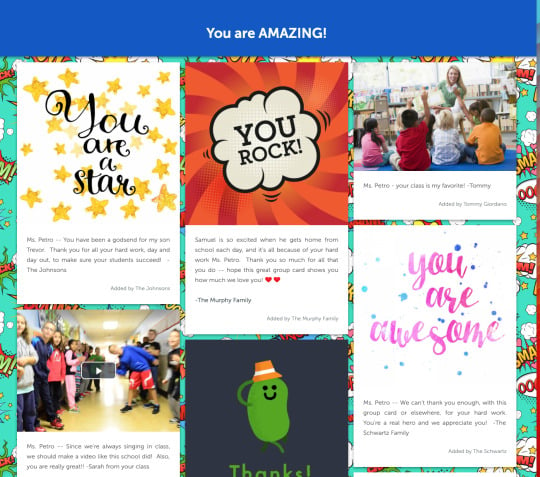“The deepest principle in human nature is the craving to be appreciated.” – William James.
We all want to feel appreciated at work. To make appreciation easier, many companies are starting to use employee recognition programs, and you might be wondering: do employee recognition programs work?
The short answer is, yes they do work — when implemented correctly. Let’s dive into employee recognition programs deeper to understand the key benefits and how to create an effective program at your organization.
What Is an Employee Recognition Program?
An employee recognition program helps companies streamline and standardize their recognition process. It structures the practice of employee recognition (acknowledging your employees’ contributions to the company) so all company members can recognize each other. The best recognition programs make it easy for all types of recognition: top-down, peer-to-peer, and bottom-up.
Why Employee Recognition Programs Work
Employee recognition often falls in that dreaded “important but not urgent” category. We all know it’s important to improve morale and retention, but it’s too easy to get lost among other priorities. A recognition program can help prevent that by creating a consistent and user-friendly approach that helps all employees create a culture of recognition. When companies start to utilize authentic recognition consistently, they see a positive change not only in their organization but also in the people who work there.
A few benefits of an effective employee recognition program:
- Motivation: People like to be recognized and appreciated for their hard work, plain and simple. Recognizing employees is a powerful motivator for employees to continue performing at their best.
- Job Satisfaction: Employees who feel valued and appreciated are more satisfied with their jobs. Plus, employees who are consistently recognized and noticed by management or leadership also feel a stronger connection to their company, which helps them feel happier at work.
- Employee Engagement: Similar to motivation, employees who know their hard work will be recognized are more engaged in their work and in the organization overall.
- Employee Retention: Authentic recognition can significantly improve employee retention rates. Employees who feel appreciated and engaged at work are less likely to leave. And for the financially minded reader, improving employee retention also helps reduce turnover costs within the organization.
- Positive Work Environment: Creating a work environment where authentic appreciation and recognition are encouraged helps to create a positive work culture. Recognition, especially peer-to-peer recognition, promotes teamwork and encourages employees to support one another. Recognition also helps employees feel a sense of belonging within the organization.
- Attracting Top Talent: Having an effective employee recognition plan can help to attract top talent to an organization. Recognition can start on day 1 (or before) with simple onboarding steps like a heartfelt welcome message.

When Employee Recognition Programs Won’t Work
Unfortunately, there are times when employee recognition programs don’t work for a company. Let’s review some reasons why they won’t work.
- Leadership Isn’t On Board
If the company’s leadership and management don’t use the program, then none of the employees will. The company’s leadership sets the example for everyone else, so getting them on board, trained, and excited to use the program is the first step to a successful engagement program rollout. - Fragmented Corporate Culture
A fragmented company culture happens when there is a lack of cohesion and unity among employees and departments. A lack of communication, poor teamwork, inconsistent values, and a sense of disconnect among employees can lead to a fragmented culture. If a company tries implementing a new employee recognition program with a (or to fix a) fragmented culture, the results will likely be mixed. Some departments may pick it up, while others won’t. This can lead to a lack of unified recognition and actually worsen disconnect in the organization. - Employee Recognition Platform Isn’t User Friendly
Most organizations don’t do enough recognition as is. A new software or program won’t get used if employees don’t understand it! Because some people may not see recognition as a necessary task, learning to use the application won’t be a priority. Any employee recognition software needs to be user-friendly to be effective. - Company Didn’t Train Everyone
Another roadblock companies might encounter when implementing a new recognition program is training only leadership and management. This can make the program ineffective because some employees may not know how to use it — or even know it exists! Since the best employee recognition programs are top-down, peer-to-peer and bottom-up, training the wider team is essential to a successful launch. - Inconsistent Use
At worst, inconsistent use of a recognition program could be seen as favoritism. At best, the recognition is seen as irregular and not timely. That doesn’t yield the same results for the company and doesn’t encourage employees to use the platform. - Lack Of Personalization
A program with a one-size-fits-all approach will feel inauthentic and disingenuous to employees. Employees won’t feel valued for their contributions if all they see is generic praise or a points board. Generic and vague praise is not specific or direct recognition.
How To Create An Effective Employee Recognition Program
To build a successful employee recognition program, follow these guidelines:
- Define your company culture. That way you can ensure that the program fits your company’s culture and mission.
- Send engagement surveys to your employees to find out how they would like to be recognized. Use that to narrow your search for a program or platform.
- Define recognition criteria. What kinds of recognition do you want to prioritize and highlight?
- Ensure the program includes personalized recognition. Most people crave authenticity in their recognition.
- Encourage peer-to-peer recognition. The most successful employee recognition programs are not top-down.
- Ensure leadership and management are on board. If the company’s higher-ups aren’t interested, the program won’t be successful.
It can be a lot of work to create and implement an employee recognition program. Putting someone on your HR team solely in charge of employee recognition can help to alleviate some of that stress. That person will become your resident expert, and make sure the employee recognition program will work with the company’s culture. It also signals to the wider team that the company is taking recognition seriously.
Read More: 15 Questions To Ask In Selecting Employee Recognition Software

Examples of Employee Recognition Efforts
Companies can start employee recognition efforts in several ways. Depending on your organization’s culture and history with recognition, you can start with smaller efforts or a wider program. Here are some examples of varying complexity and impact.
Shout-outs
A simple shout-out in a team meeting, over Slack or Teams, or in an email blast is a simple and cost-effective act of recognition. Effective shout-outs are short, specific, and personal to the recipient. To get the team in the habit, set dedicated time during team meetings or set a day of the week for shout-outs.
Employee Of The _______ Awards
Employee of the ____ is a classic award that can be given monthly, quarterly, or yearly. The best programs give employees something to aspire to. To make this award work, ensure that clear criteria are established so no one assumes favoritism. Typically, the company gives winning employee a certificate or plaque, plus public acknowledgment.
Recognition Boards
An employee recognition board is a simple and effective way to start recognizing your team. There are many different ways to make a recognition board: traditional bulletin boards, in-office digital display screens, online shout-out boards, and more. Companies can use Kudoboard to create a public recognition board that everyone can contribute to.
A recognition board can also have a theme, such as:
- Spotlight Of The Month: Similar to employee of the month, this board shines a spotlight on an employee who has gone above and beyond.
- Customer Service Champ: This board recognizes employees who have done an excellent job with customer service.
- Team Dynamics Wall: A board dedicated to recognizing team members who embody teamwork and collaboration, or other company values.
- Success Stories: This board is dedicated to showcasing employee success stories, whether related to projects, sales, or other workplace accomplishments.
- Random Acts of Kindness: Creating a board that lets employees acknowledge peers’ kind acts is a great way to create a ripple effect of kindness and a positive work culture.
Personalized Gifts
Employee appreciation gifts don’t have to be boring and generalized. A personalized appreciation gift is a great way to let employees know they are valued. Instead of sending the same generic gift to everyone, allow people to choose their own gift with gift cards or experiences.
Milestone Awards
Celebrating your employees’ work anniversaries is a great way to recognize their contributions to the company. Milestone awards are often given at years 1, 5, 10, 15, 20, and so on. A work anniversary is a perfect opportunity to pause and reflect on everything someone does for the company and team.
Team Celebrations
Employees can be recognized by hosting fun team celebrations. A team celebration shows team members how much you appreciate their efforts and helps to foster team unity and culture. Here are a few ideas teams can use:
- Escape Rooms (Virtual or in-person)
- Book Club
- Karaoke Party
- Talent Show
- Team Lunch
To be effective, you want to choose a celebration the whole team will enjoy. Send out a survey with a few choices and allow the team to choose the activity.
Powering Employee Recognition with Kudoboard
As we’ve seen, employee recognition programs work — when implemented correctly. A software option with easy implementation, Kudoboard makes boosting morale and increasing connection among employees easy.
Not only does Kudoboard provide a place for authentic recognition across the org chat, but companies can also track recognition and engagement metrics. With these analytics, companies can track boards, posts, engagement, users, and more to help ensure accountability and progress with the program.
Plus Kudoboard seamlessly integrates with programs you already use (Slack, Teams, HRIS systems), making it user-friendly. With Kudoboard, you get support and resources to ensure the platform will work for you and your employees.

FAQs about Employee Recognition Programs
How To Introduce An Employee Recognition Program?
Rolling out a new recognition program can seem daunting. Follow these steps once your company has built or bought an employee recognition program to ensure a successful launch.
- Educate Leadership First: Ensure that all leadership is involved and ready to participate in the program. This step is essential to its success.
- Develop a Guide: Write an employee recognition guide for your organization. Make it easy to read and follow. The guide will explain the purpose and benefits of the program, and how employees can start using it.
- Train Employees: Providing training helps introduce the program. It also helps employees understand how to use the platform and see the value of participating.
- Create an Employee Recognition Committee: The Committee’s role includes promoting the program, tracking metrics, and recommending improvements.
- Continue to Monitor and Adjust: The work isn’t done once the program is introduced. In fact, it’s only beginning! For the recognition program to succeed, companies must continue to monitor and adjust as needed. Monitor metrics, gather feedback, and find ways to improve the program for all employees.
Why Should I Use An Employee Recognition Program?
There are numerous benefits to employee recognition, including boosting employee morale, increasing employee engagement, reducing turnover, and so much more. The purpose of an employee recognition program is to help streamline the recognition process, making it easier for EVERYONE at the company to participate in recognition efforts. If you want all the benefits of employee recognition, using an employee recognition program is a great way to get started.
Get started with Kudoboard for Employee Recognition
Start your company’s employee recognition program with Elevate by Kudoboard.




